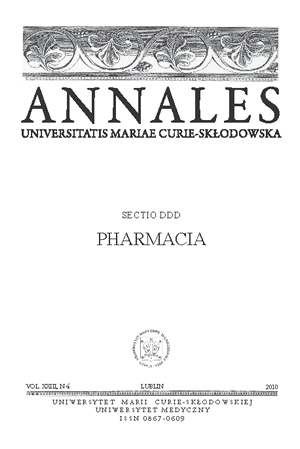Czerwone wino przeciwdziała stresowi nitracyjnemu i nadaktywności PARP-1 w siatkówce szczurów z cukrzycą
Słowa kluczowe:
retinopatia cukrzycowa, polifenole, stres oksydacyjno-nitracyjny, polimeraza Poli(ADP-rybozy)Abstrakt
Zwiększona akumulacja nitrotyrozyny i Poli-ADP-ribozylowanych białek w tkankach chorych z cukrzycą są związane z powikłaniami cukrzycy (neuropatią cukrzycową, nefropatią i retinopatią). Badania wykazały, że czerwone wino zmniejsza poziom modyfikowanych nitrotyrozyną i i poli-ADP-ribozylowanych białek w siatkówce szczurów z cukrzycą w porównaniu z grupą kontrolną. Te dane pozwalają wnioskować, iż czerwone wino i jego preparaty polifenolowe odgrywają istotną rolę w prewencji i leczeniu powikłań cukrzycy.
Bibliografia
1. Asnaghi V. et al.: A role for the polyol pathway in the early neuroretinal apoptosis and glial changes induced by diabetes in the rat. Diabetes, 52, 506, 2003.
2. Brownlee M.: The pathobiology of diabetic complications: a unifying mechanism. Diabetes, 54, 1615, 2005.
3. Dagher Z. et al.: Studies of rat and human retinas predict a role for the polyol pathway in human diabetic retinopathy. Diabetes, 53, 2404, 2004.
4. Drel V.R. et al.: Poly(ADP-ribose)polymerase inhibition counteracts cataract formation and early retinal changes in streptozotocin-diabetic rats. Invest. Ophthalmol. Vis. Sci., 50, 1778, 2009.
5. Dunger D.B. et al.: European Society for Paediatric Endocrinology; Lawson Wilkins Pediatric Endocrine Society. European Society for Paediatric Endocrinology/Lawson Wilkins Pediatric Endocrine Society consensus statement on diabetic ketoacidosis in children and adolescents. Pediatrics, 113, e133, 2004.
6. Frank R.N.: Diabetic retinopathy. N. Engl. J. Med., 350, 48, 2004.
7. Lodovici M. et al.: Antioxidant and radical scavenging properties in vitro of polyphenolic extracts from red wine. Eur. J. Nutr.; 40, 74, 2001.
8. Neuenschwander H. et al.: Dose-dependent reduction of retinal vessel changes associated with diabetic retinopathy in galactose-fed dogs by the aldose reductase inhibitor M79175. J. Ocul. Pharm. Ther., 13, 517, 1997.
9. Obrosova I.G., et al.: Early diabetes-induced biochemical changes in the retina: comparison of rat and mouse models. Diabetologia, 49, 2525, 2006.
10. Pacher P., et al.: Nitric oxide and peroxynitrite in health and disease. Physiol. Rev., 87, 315, 2007.
11. Santilli F. et al.: The role of nitric oxide in the development of diabetic angiopathy. Horm. Metab. Res., 36, 319, 2004.
12. Tsang C. et al.: The influence of moderate red wine consumption on antioxidant status and indices of oxidative stress associated with CHD in healthy volunteers. Br. J. Nutr., 93, 233, 2005.
Pobrania
Opublikowane
Numer
Dział
Licencja
Prawa autorskie (c) 2025 Viktor Drel, Anatoliy Yalaneckyy, Volodymyr Mizin, Viktor Zagoruyko, Viktoria Gerzhykova, Nataliya Sybirna (Autor)

Praca jest udostępniana na licencji Creative Commons Attribution-NonCommercial-NoDerivatives 3.0 Unported License.


